As a FixThePhoto photographer, I frequently design custom photo props, specialty frames, and other personalized items for client projects. This is why I decided to research the 3D printing services since they provide the perfect answer for bringing these unique designs to life.
However, I soon discovered that while 3D printing was really great, there are several key challenges to take into account like print precision, material versatility, service consistency, and turnaround times. These details are crucial especially when working with detailed, personalized creations.
I undertook thorough research into leading 3D printing services. My investigation included analyzing top providers through Google searches and examining user feedback on platforms including Reddit, Quora, and YouTube. Additionally, I collaborated with experienced colleagues in the 3D printing field and we tested over 20 services.
We tested each provider based on five critical factors: print precision, material selection, shipping efficiency, production speed, and support quality. Our real-world research showed us which services actually work as advertised, so we can suggest only the truly good ones for people who need 3D-printed items.
| Service Provider | Materials | 3D Printing Technologies | Print Quality | Minimum Order | Worldwide Shipping |
|---|---|---|---|---|---|
|
100+
|
20+
|
High
|
❌
|
✔️
|
|
|
5
|
6
|
High
|
❌
|
✔️
|
|
|
50+
|
10+
|
Good
|
❌
|
✔️
|
|
|
60+
|
7+
|
Good
|
❌
|
✔️
|
|
|
30+
|
10+
|
High
|
❌
|
✔️
|
|
|
20+
|
8+
|
Good
|
❌
|
✔️
|
|
|
100+
|
5+
|
Good
|
❌
|
✔️
|
I carefully selected 3D printing services based on three key factors: available materials (like metal for jewelry or durable plastics for sculptures), print quality (needing precise dimensions and smooth finishes), and transparent pricing (with clear cost estimates). This approach helped me find the perfect match for each project's specific requirements.
Fast delivery was crucial for my urgent projects. I liked services with easy-to-use websites for quick ordering. Besides, I always checked reviews and picked companies known for good customer service to avoid problems.
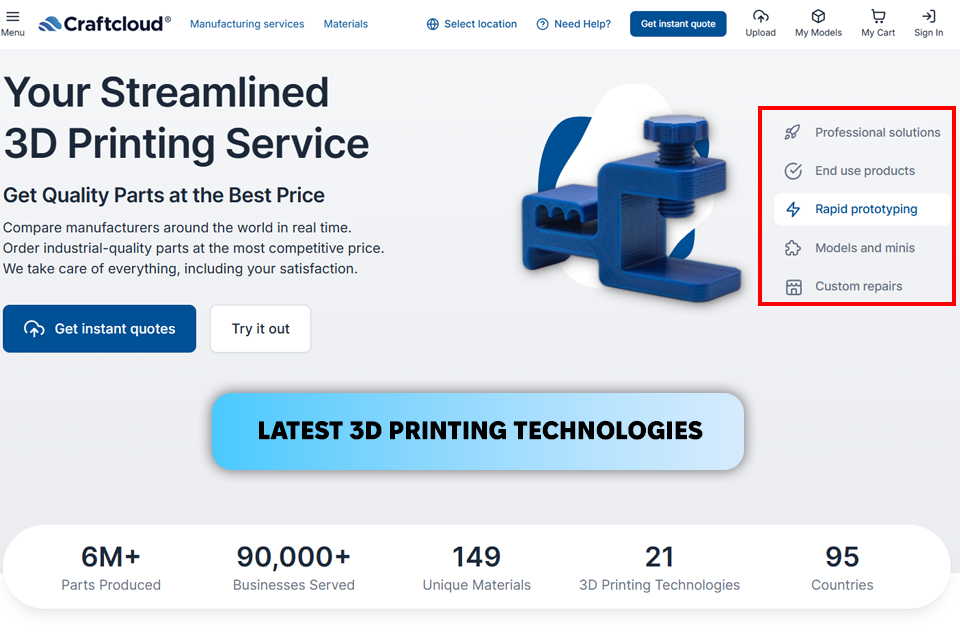
I tried out Craftcloud’s online 3D printing service for some of my 3D printing ideas. I ordered a retro-style camera model and a flower prop. Uploading my files was a breeze, and I got a price quote right away, which was awesome. I chose PLA plastic for both, and their customer support was very responsive: they helped me pick the best materials for my designs.
The site allows checking prices from different makers around the world instantly. Ordering was easy, and when my stuff arrived, it looked great! However, some items took longer to ship than I expected. A few materials also didn’t have as many finish options as I’d like, but considering the total price of $60, I was pretty happy with how everything turned out.
Eva also tried Craftcloud for her project’s custom pieces. She liked that it accepted common 3D file types like STL and OBJ, plus, all uploads were private and secure. With 20+ printing methods (like FDM, SLA, and laser cutting) and over 100 materials to pick from, the options were virtually limitless. After testing it out, we both agreed: Craftcloud’s a solid choice for top-notch 3D prints.
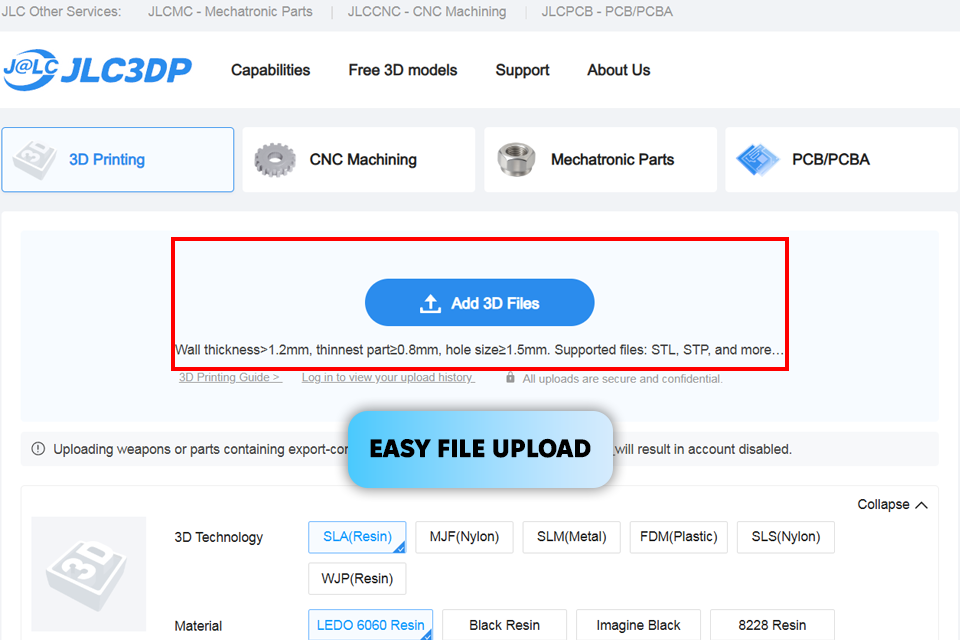
I tried out JLC3DP by ordering custom word signs (“love”) for my photo shoots. Uploading my design file was super easy: I just needed to drag and drop it right on their website. I picked resin as my material, and getting an instant price quote saved me tons of time. This is an ideal service for quick projects.
The whole process was quick and easy, and my props were ready in just 24 hours. The print quality blew me away, with perfect details exactly like I wanted. They work with resin, nylon, metal, and plastic, using pro-level printers (like MJF and SLS). The output was even better than I expected, and the final pieces matched my vision perfectly. The affordable prices starting from $1 were another huge advantage for me. The total cost of my order was $30.
The custom resin material was a bit expensive (not surprising considering quality, though some budget options would’ve been helpful), and shipping costs were higher than I thought. But when Eva tested the “love” signs in her shoot. They were lightweight yet sturdy, with a polished resin finish that jazzed up photos.
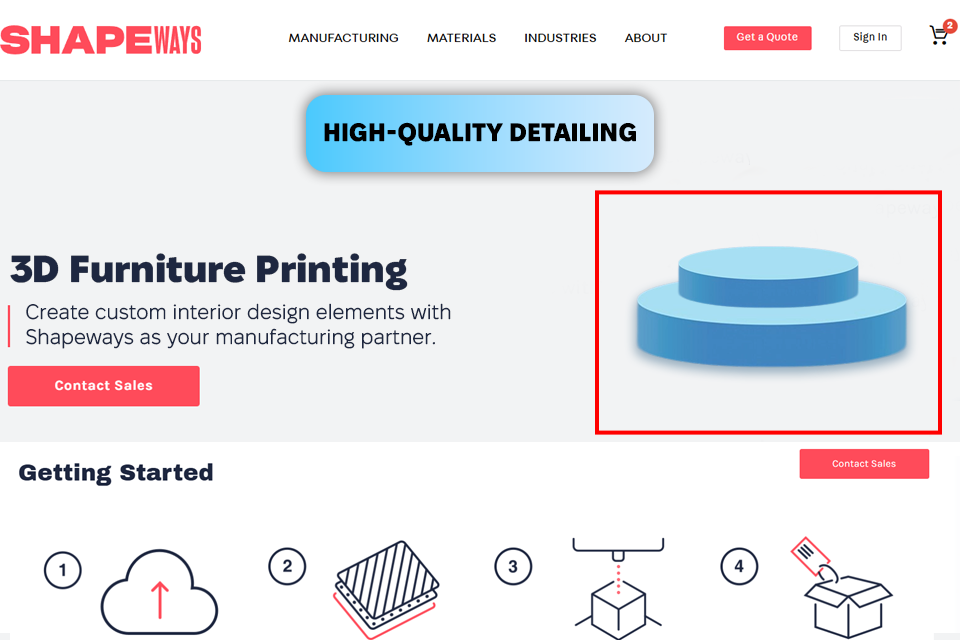
I used Shapeways to order a custom display stand for a product shoot. Uploading my 3D file was easy and their system even checked it to make sure the printed version would look nice. As for materials, I chose their strong and flexible plastic because it’s durable, looks smooth, and works great for my product photography needs, providing both strength and a sleek look.
The file feedback feature came in handy as well. Shapeways' expert 3D printing operators gave me comprehensive feedback about my model and helped me polish the design before launching the printing process. Their expertise really elevated the service. I was especially impressed with the fast turnaround provided by this print on demand site for beginners. My order was ready in just two business days (and arrived in flawless condition).
The stand worked perfectly: lightweight but strong, keeping my product securely in place during the shoot. While the $45 price was reasonable, Shapeways can get pricey for complex designs or premium materials. Although they don't offer fast shipping, the stand was a breeze to adjust. Eva especially liked how simple it was to use.
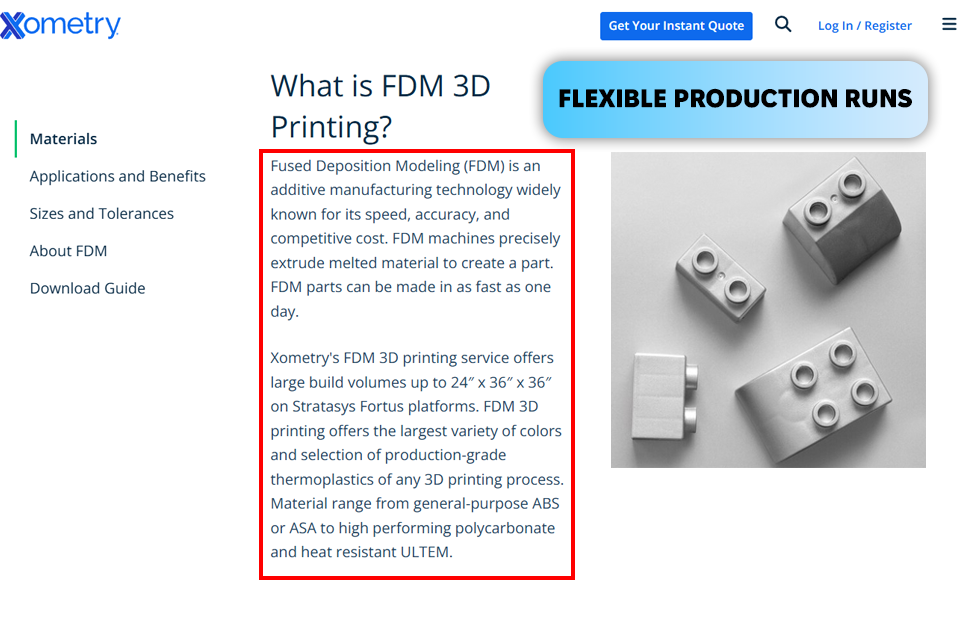
I tried Xometry's 3D printing lego service to make custom LEGO-style photo props: small, detailed pieces I could arrange creatively in shots. After uploading my design, I got an instant quote and delivery estimate. I selected SLS Nylon for its durability and smooth finish, which is perfect for crisp details. My set of blocks costs just $60 with free U.S. shipping.
The quality of the output was outstanding. The SLS nylon pieces were perfect for photos - smooth finish, crisp edges, and precise details. They were surprisingly light but still durable. Xometry uses top-tier 3D printers from Stratasys, EOS, Concept Laser, SLM Solutions, 3D Systems, etc.
The parts arrived in plain white, so I painted them myself to make them pop in photos. Eva put them to the test in a tricky product shoot, checking how they stacked and held up under different lights and angles. They worked flawlessly.
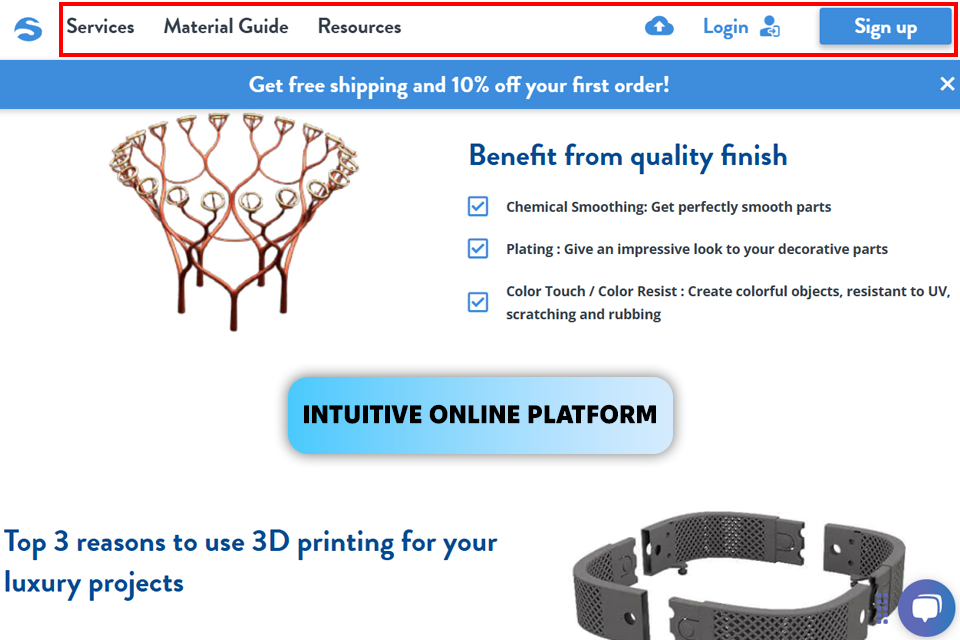
To evaluate Sculpteo's 3D printing services for jewelry, I ordered a custom pendant designed specifically for photoshoots. After uploading my 3D model to their platform, I immediately received a pricing estimate. I noticed that model uploads and adjustments may cause performance issues on older computer systems.
For material selection, I chose Direct Metal Laser Sintering (DMLS) in Sterling Silver - this technology's precision enables complex geometries while delivering both durability and premium surface quality. The order cost me $120, including domestic U.S. shipping.
With its diverse metal options, Sculpteo serves jewelry makers well. My pendant arrived in 5 days and amazed me with its quality. It featured flawless finishing: smooth surfaces, sharp edges, and no visible layering. This is because the company takes advantage of the precision of industrial 3D printers like Concept Laser, EOS, SLM Solutions, etc.
While the print was high-quality, I would have liked additional post-processing choices like polished silver or antique finishes directly from Sculpteo. Eva liked how the pendant looked under professional lights - the metal shone nicely and kept its fine details even when viewed up close. But she thought it would look even better in close-up photos if it had a polished finish.
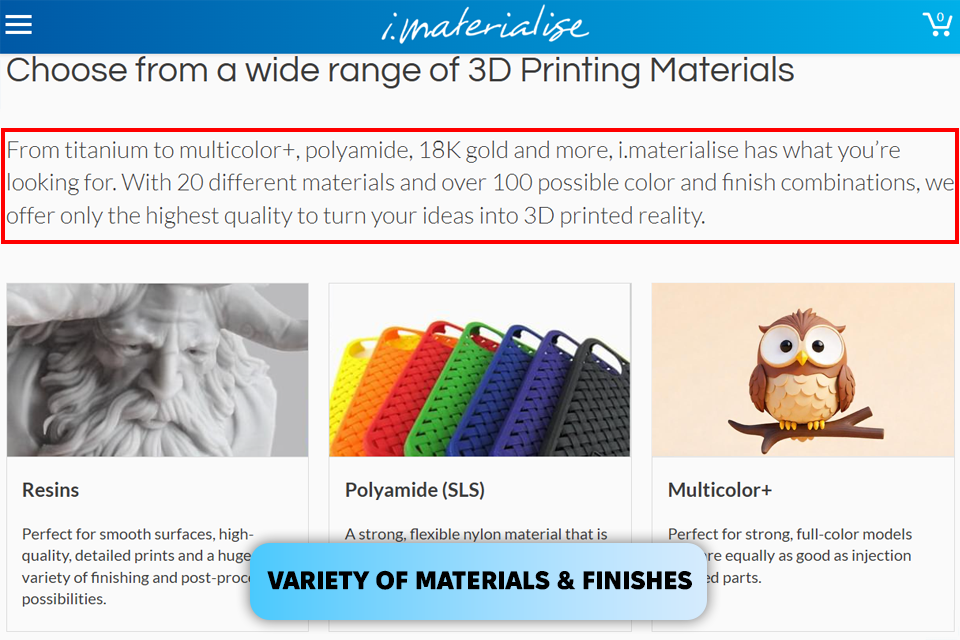
Lately, I needed a 3D printing service for sculptures and figures like owls, so I turned my attention to Materialise. I used a free 3D model from Adobe Stock. I submitted my owl sculpture design to Materialise's platform, opting for white Polyamide (SLS Nylon) due to its strength, intricate detail reproduction, and smooth finish, which is ideal for post-processing like painting. With a vast selection of 20+ materials (including titanium, multicolor+, polyamide, and even 18K gold) and 100+ finishing options, finding the right option was effortless.
When the figure arrived, I was amazed by the results. The owl's feather details and patterns were crisp, and the polished polyamide surface was smooth with no visible print lines. Despite being lightweight, it felt sturdy, which is ideal for photoshoots.
The total cost was $85, covering both production and shipping. The service printed and delivered my order in just 6 days. While Polyamide allows for rush processing (under 2 days), other materials have longer production times and don't offer express service.
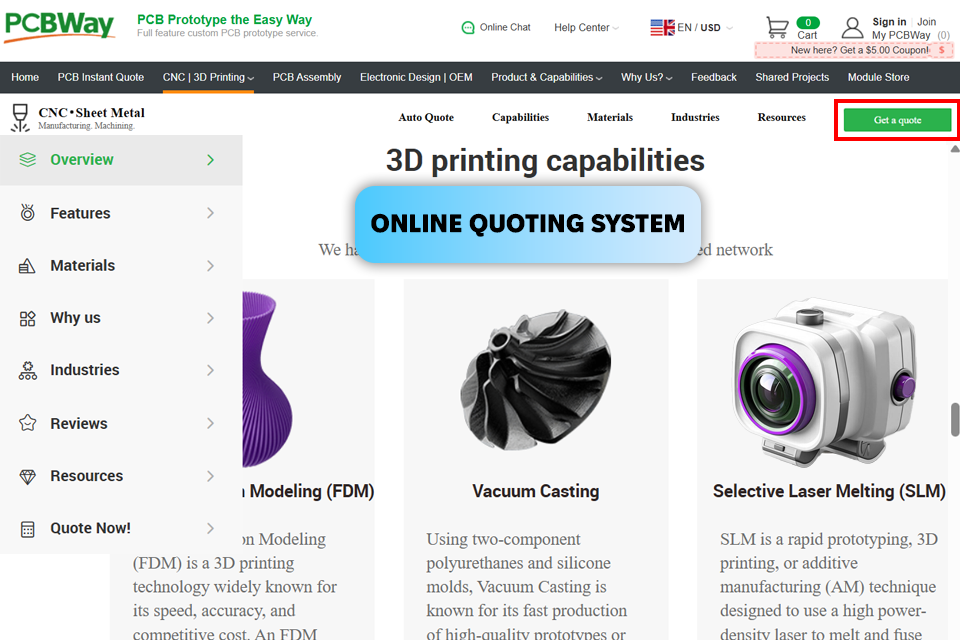
I recently ordered a custom miniature camera as a gift for a colleague. Since PCBWay is known as one of the best 3D printing services for miniatures, I decided to try it out. I designed the camera model in 3D modeling software like Autodesk Maya, then uploaded it to PCBWay’s site and chose Resin because of its smooth, high-quality finish.
After getting an instant quote, I chose a matte black resin finish to replicate the look of a real DSLR. The total cost was $98, covering both printing and shipping. When the miniature arrived, I was amazed by its accuracy.
The SLA resin captured every tiny detail, creating a near-perfect scaled-down version of a professional camera. The finish was flawlessly smooth, and the material felt premium in hand. My colleagues from FixThePhoto, Eva and Kate were thrilled with it, saying the miniature looked exactly like a real camera.
During our evaluation of multiple 3D printing services like 3D On Demand, JawsTec, Protolabs Network, Treatstock, FacFox, Print a Thing, BigRep, and 3DSPro, we assessed key factors such as print quality, user experience, cost efficiency, and customer service. We noticed big differences in print quality between services.
The best ones created smooth, perfectly detailed objects, while others had noticeable flaws like rough textures or slightly misaligned layers - problems that became more obvious with delicate designs.
For me, Craftcloud became a top choice, thanks to its intuitive platform, quick turnaround times, and consistently high-quality outputs, as well as AI-powered design optimization tools. JLC3DP took second place, offering exceptional print accuracy and an unmatched range of materials, though with slightly shorter production cycles. Shapeways earned third place, offering an impressive variety of materials and post-processing options, though its high price and delayed support responses held it back.
We evaluated how intuitive each platform was for both new and advanced users, checking how easy it was to upload models, choose materials, and adjust settings. We also assessed their design flexibility including template libraries, AI-assisted tools, and customization features.
We looked at the variety of materials available like plastic, metal, and eco-friendly options, and whether the services recommended the right material for each project. We also checked color options. While certain providers boasted a wide spectrum of colors and textures, others had more restricted palettes and finish choices.
We checked how long each print took from start to finish. When the models arrived, Eva and I examined how precise they were, how smooth they felt, and how well the structural integrity, especially for complex designs, was preserved.
We researched prices for the same project across different services, taking into account material costs, delivery fees, and any extras like rush orders. We also tested customer service by reporting issues related to 3D printing to see how quickly and effectively they helped resolve them.